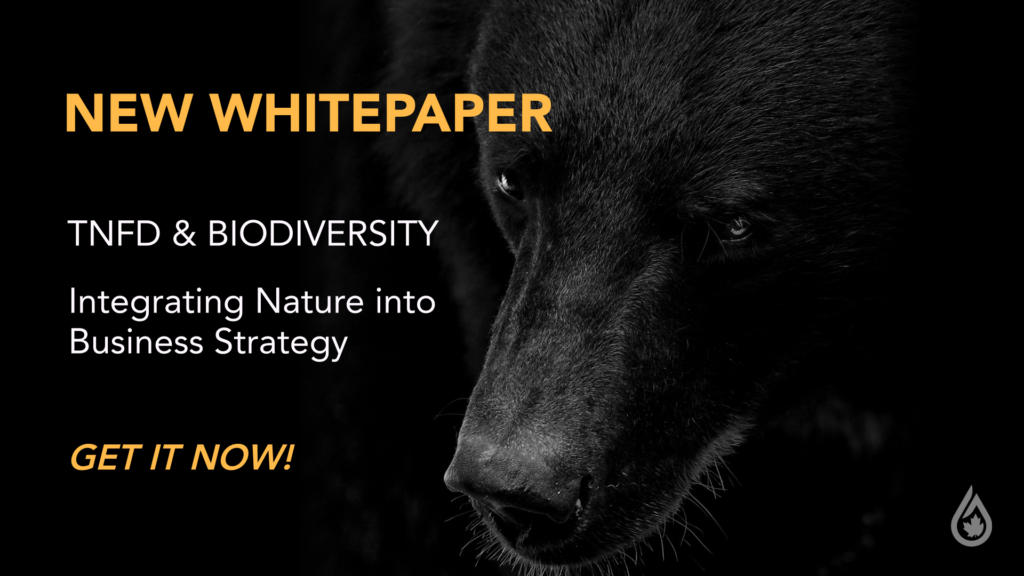Integrating TNFD into Your Biodiversity Strategy for Success
In today’s business landscape, integrating TNFD into your biodiversity strategy is critical for managing environmental risks effectively. Companies that fail to incorporate biodiversity in their Environmental, Social, and Governance (ESG) frameworks face potential supply chain disruptions, reputational damage, and even regulatory penalties. Yet, many organizations still focus more on emissions and climate impact, leaving biodiversity as a secondary concern. This gap in risk management can lead to long-term sustainability challenges.

This article outlines why biodiversity is essential to your ESG strategy and provides actionable steps to begin addressing these risks. For those seeking deeper insights, our whitepaper, “TNFD & Biodiversity – Integrating Nature into Business Strategy,” offers a comprehensive guide to managing biodiversity risks.
Why Biodiversity is Key to Your ESG Strategy
Biodiversity underpins the natural systems businesses rely on for essential resources such as clean water, fertile soil, and raw materials. According to the World Economic Forum, more than half of global GDP depends on nature. Ignoring biodiversity introduces several risks:
Supply Chain Vulnerability
If your business relies on natural resources such as agriculture or forestry, biodiversity loss can lead to raw material shortages and higher operational costs.
Reputational Risk
As consumer awareness of sustainability grows, companies that fail to adopt biodiversity-friendly practices risk losing consumer trust and investor confidence.
To mitigate these risks, it’s crucial to embed biodiversity into your ESG strategy, allowing your business to manage risks more effectively and contribute to global sustainability goals.

Three Practical Steps to Strengthen Your Biodiversity Strategy
Here are three actionable steps you can implement today to align your ESG framework with biodiversity best practices. These steps offer immediate value while setting your organization up for long-term success.
1. Map Your Dependencies on Nature
To manage biodiversity risks, it’s essential to understand where your business depends on nature. Mapping these dependencies will allow you to identify vulnerable areas in your supply chain or operations that are at risk due to biodiversity loss.
Tools like ENCORE (Exploring Natural Capital Opportunities, Risks, and Exposure) can help businesses map out these dependencies and assess how biodiversity impacts their operations.
Actionable Tip
Conduct a biodiversity impact assessment to identify the natural resources critical to your operations. For more detailed guidance, download our whitepaper, “TNFD & Biodiversity – Integrating Nature into Business Strategy.”
2. Set Measurable Biodiversity Goals
Once you have mapped your biodiversity dependencies, it’s important to set clear, measurable goals that align with global sustainability targets. Your biodiversity goals should be SMART (Specific, Measurable, Achievable, Relevant, and Time-bound) to ensure trackable progress.
For example, if your business relies on forest products, you could set a goal to eliminate deforestation from your supply chain by sourcing from certified sustainable suppliers.
Actionable Tip
Start with one biodiversity goal that directly addresses a key risk in your business. For more detailed advice on setting goals, our whitepaper provides an in-depth roadmap for creating effective biodiversity targets.
3. Engage Stakeholders
Engaging both internal and external stakeholders is essential to the success of your biodiversity strategy. Internally, employees need to understand how their roles contribute to biodiversity goals. Externally, it’s important to collaborate with suppliers, customers, and local communities to ensure sustainable practices are adopted across your value chain.
Actionable Tip
Host internal workshops to educate your teams on the importance of biodiversity, and build partnerships with external stakeholders to ensure their practices align with your biodiversity objectives. Our whitepaper includes detailed advice on how to engage stakeholders and build strong partnerships.
Why Expert Guidance is Important for Biodiversity Management
While the steps outlined above provide a solid foundation, navigating biodiversity management can be complex. Free tools like ENCORE are helpful, but accurately interpreting the data and aligning efforts across departments can be challenging. Often, expert guidance is needed to ensure the effective implementation of biodiversity strategies.
At Green Quarter ESG, we connect businesses with experts who can guide them through the complex process of managing biodiversity risks. Whether you need assistance with biodiversity assessments, setting goals, or engaging stakeholders, our network of professionals can help you develop a comprehensive and effective biodiversity strategy.
For businesses looking to take the next step, our whitepaper, “TNFD & Biodiversity – Integrating Nature into Business Strategy,” offers a detailed guide on how to successfully integrate biodiversity into your ESG framework.
Key Takeaways
- Map your biodiversity dependencies using tools like ENCORE to identify vulnerable areas in your business.
- Set SMART biodiversity goals that align with global sustainability targets and address key business risks.
- Engage both internal and external stakeholders to ensure a collaborative, long-term approach to sustainability.
To dive deeper into how you can future-proof your business by integrating biodiversity into your ESG strategy, download our whitepaper, “TNFD & Biodiversity – Integrating Nature into Business Strategy.”



